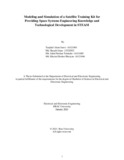| dc.contributor.advisor | Azad, A. K. M. Abdul Malek | |
| dc.contributor.author | Sanvi, Tanjidul Islam | |
| dc.contributor.author | Islam, Md. Shoaib | |
| dc.contributor.author | Talukder, Md. Jahid Hashan | |
| dc.contributor.author | Bhuiyan, Md. Khairul Bashar | |
| dc.date.accessioned | 2021-07-14T05:32:22Z | |
| dc.date.available | 2021-07-14T05:32:22Z | |
| dc.date.copyright | 2021 | |
| dc.date.issued | 2021-01 | |
| dc.identifier.other | ID: 16321001 | |
| dc.identifier.other | ID: 13321052 | |
| dc.identifier.other | ID: 16321005 | |
| dc.identifier.other | ID: 16121046 | |
| dc.identifier.uri | http://hdl.handle.net/10361/14798 | |
| dc.description | This thesis is submitted in partial fulfillment of the requirements for the degree of Bachelor of Science in Electrical and Electronic Engineering, 2021. | en_US |
| dc.description | Cataloged from PDF version of thesis. | |
| dc.description | Includes bibliographical references (pages 67-70). | |
| dc.description.abstract | Aerospace Engineering is a flourishing branch of modern engineering nowadays. To introduce the
topic to the students, many space programs have been taken lately at the graduate and post-graduate
levels. As a result, space technological knowledge and research has been limited to graduate and
doctorate students. However, undergraduate, college, and school students do not get proper access
to space-related knowledge. Again, as big satellites are costly and too complex, nowadays small
satellites are very popular for educational and technology demonstration purposes. However, for
school and college students, it is very hard to understand the system and functions of small
satellites due to the limitation of space system knowledge. Generally, there are few satellite
training kits are available in the international market which is very much expensive. The complete
simulator of such a satellite training kit with a proper curriculum guide can eradicate the limitation
of the availability of space education and keep growing interest among the students about satellite
technology. In this thesis project, a systematic architecture has been proposed that can provide the
students with space systems engineering experience through simulation, assembly, integration, and
operation of a satellite training kit. The whole architecture has four parts – 1) Simulation, 2)
Mechanical, 3) Electrical, and 4) Software. In this thesis, to prove our whole concept we will
complete the mechanical and electrical simulations of the satellite training kit. | en_US |
| dc.description.statementofresponsibility | Tanjidul Islam Sanvi | |
| dc.description.statementofresponsibility | Md. Shoaib Islam | |
| dc.description.statementofresponsibility | Md. Jahid Hashan Talukder | |
| dc.description.statementofresponsibility | Md. Khairul Bashar Bhuiyan | |
| dc.format.extent | 86 Pages | |
| dc.language.iso | en_US | en_US |
| dc.publisher | Brac University | en_US |
| dc.rights | Brac University theses are protected by copyright. They may be viewed from this source for any purpose, but reproduction or distribution in any format is prohibited without written permission. | |
| dc.subject | Modeling and Simulation | en_US |
| dc.subject | Satellite Training Kit | en_US |
| dc.subject | Aerospace Engineering | en_US |
| dc.subject | Space system knowledge | en_US |
| dc.subject | STEAM | en_US |
| dc.title | Modeling and simulation of a satellite training kit for providing space systems engineering knowledge and technological development in STEAM | en_US |
| dc.type | Thesis | en_US |
| dc.contributor.department | Department of Electrical and Electronic Engineering, Brac University | |
| dc.description.degree | B. Electrical and Electronic Engineering | |

